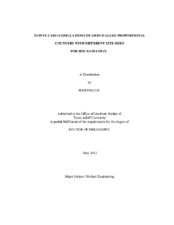| dc.description.abstract | Tissue-equivalent proportional counters are frequently used to measure dose and dose equivalent in cosmic radiation fields that include high-Z, high-energy (HZE) particles. The fact that particles with different stopping powers can produce the same energy deposition in the same detector means that the measure of lineal energy cannot provide enough information to evaluate the equivalent dose due to HZE particles. To characterize incident particles by mass and velocity, a multiple-detector system composed of three tissue-equivalent proportional counters simulating different size tissue volumes was proposed to be built. This system took advantage of the well-known fact that lineal energy (y) of a HZE particle depends on the site size, as well as the particle mass and energy.
Monte Carlo calculations were used to evaluate lineal energy, using GEANT4, in grid-walled (wall-less) proportional counters with simulated unit density site diameter of 0.1, 0.5 and 2.5 micrometers in a uniform HZE particle field. Uniform beams of 1000 MeV/n and 100 MeV/n 56Fe26+, 28Si14+, 16O8+, 12C6+, 4He2+ ions and proton particles bombarding the detectors were simulated. The results of the calculations were used to determine how much additional information about particle charge and velocity could be obtained from such a detector system. Comparison of simulation results with those of walled detectors was included in the study to illustrate the wall effect.
The results shows that the detector system is capable of characterizing HZE particles in a mixed unknown field based on the lineal energy spectra as well as the calculated mean lineal energy. This suggests that it may be practical to use such a system to measure the average particle velocity of HZE particles in space. The parameters used in the simulation are also good references for detector construction. There is only limited experimental data for lineal energy resulting from a large uniform field of HZE particles incident on a wall-less detector. However, the Monte Carlo results are consistent with the experimental data available. | en |


